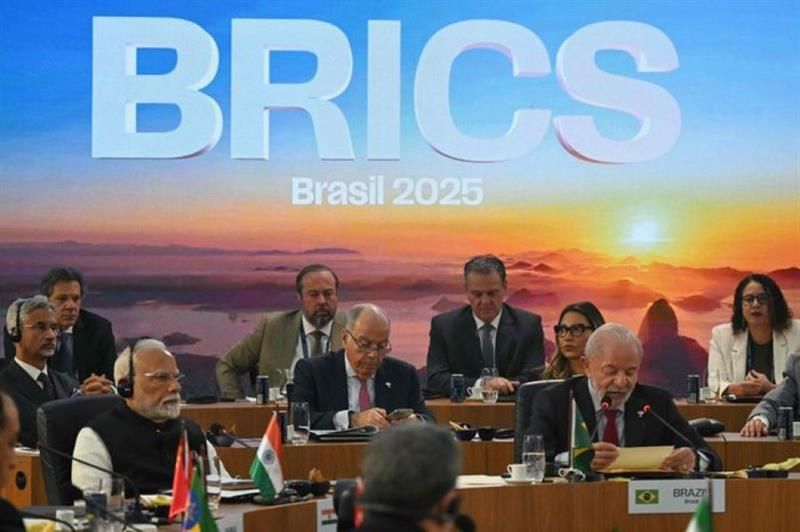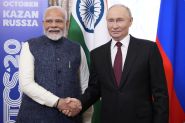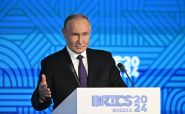- Home
- Middle East
- BRICS Summit in Rio: A Leaderless Giant in a Fractured World

Brazilian President Luiz Inácio Lula da Silva (right) speaks alongside Indian Prime Minister Narendra Modi (left) at the first plenary session of the BRICS summit in Rio de Janeiro, Brazil. ©AFP
They were meant to embody an alternative. In Rio de Janeiro, the expanded BRICS+ group of emerging powers showcased impressive numbers: over 50% of the world’s population and around 40% of global GDP. But the summit on July 6 and 7 mostly highlighted their shortcomings — a striking lack of leadership, an absence of cohesion and a political line that remains vague and cautious.
A Summit Without a Star Player
The image speaks volumes: in the group photo of the BRICS summit, the two most anticipated leaders are nowhere to be seen. Xi Jinping skipped the gathering for the first time since 2012 — officially due to a scheduling conflict. Unofficially, his absence comes amid heightened tensions with the United States, as Donald Trump, back in the White House, threatens to slap a 10% tariff on any country he deems “hostile to the American economy.”
Vladimir Putin, still under an international arrest warrant, addressed the summit via video from Moscow. His message was carefully bland, praising the BRICS’ “growing influence” and saying little else.
With the two heavyweights missing, Brazil’s President Lula took center stage. He decried the “collapse of multilateralism,” urged members not to “remain silent in the face of genocide in Gaza” and called for sweeping reforms to global institutions. But his words were met with little momentum inside the group.
The summit’s final communiqué reflected caution: it avoided naming Israel or the United States when condemning attacks on Iran, and offered no unified response to the US tariff threats. Lacking a clear direction, the summit mostly exposed the depth of internal divisions.
An Expansion That Splinters
Originally coined by economist Jim O’Neill in the early 2000s, BRICS was long seen as an economic counterweight to Western powers. In 2023, the bloc expanded to BRICS+ by adding six new members: Saudi Arabia, Iran, Egypt, the UAE, Indonesia and Ethiopia — aiming to revitalize the group and better represent the Global South.
But in Rio, that expansion exposed more cracks than cohesion.
Saudi Arabia, a close US ally, skipped the main sessions without explanation. Iran, still grappling with a recent 12-day conflict involving Israel and the US, pushed for a tougher stance but received only a watered-down statement. Egypt, a key player in Gaza, remained silent. Even mentioning a two-state solution sparked friction, with Tehran reportedly finding it too aligned with UN positions.
The splits weren’t just political. On the economic front, the group couldn’t agree on how to respond to rising US protectionism, including Trump’s threat of new tariffs. China is focused on keeping exports steady, India avoids picking a fight and others are treading carefully not to anger Washington.
A shared rivalry has yet to translate into a shared strategy. The expansion made the bloc larger, but not necessarily stronger.
Multipolar, but Directionless
On paper, BRICS+ carries weight. According to the latest IMF data, the group now accounts for 31.5% of global GDP, just ahead of the G7’s 30.7%. But in practice, it remains a coalition without a spine.
There’s no common ideology or shared stance on Ukraine, Gaza, climate change or artificial intelligence. Brazil tried to set the tone in Rio, pushing priorities like AI governance, climate reform and new financing mechanisms. But without political momentum, these remained mere proposals.
“BRICS is a useful coordination forum, but it’s not a strategic alliance,” summed up economist Sébastien Jean of IFRI in Les Echos.
The bloc may aspire to lead in a multipolar world, but without clear leadership, it ends up reflecting the complexity and tensions of the global order rather than reshaping it.
In a world where traditional alliances are fraying, BRICS+ had a chance to offer a credible alternative. For now, it remains mostly a platform for dialogue, lacking a clear vision, a recognized leader or concrete tools for action.
The summit laid bare a dual reality: undeniable demographic and economic power alongside internal struggles over coordination and political direction. These factors will determine the group’s lasting influence in the global system’s reshaping.
Read more


Comments